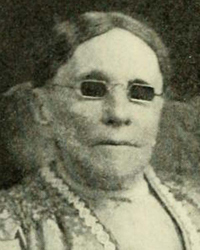History of Hymns: "I Am Thine, O Lord"
"I Am Thine, O Lord"
Fanny J. Crosby
The United Methodist Hymnal, No. 419
 |
|
Fanny J. Crosby |
I am thine, O Lord, I have heard thy voice,
and it told thy love to me;
but I long to rise in the arms of faith
and be closer drawn to thee.
Draw me nearer, nearer, blessed Lord,
to the cross where thou hast died.
Draw me nearer, nearer, blessed Lord,
to thy precious, bleeding side.
Fanny Jane Crosby (1820-1915) “set the standard for the ‘successful’ writing of gospel hymns,” according to UM Hymnal editor Carlton R. Young. She was the author of over 8,500 gospel songs.
Blind at six weeks of age, Crosby began composing texts at age 6. At 12 she began her study at the New York School for the Blind, a school she later served as a teacher. A friend of several presidents, she became one of the country’s most important advocates for the cause of the blind, addressing a session of Congress on the topic.
Her texts were set to the compositions of some of the most prominent gospel song composers of the day including William Bradbury, William Doane, Robert Lowry and Ira Sankey. Crosby composed under a number of pen names. She married blind musician Alexander Van Alstyne, and British hymnals have always used her married name, Frances Van Alstyne.
This hymn is one of many collaborations between Crosby and composer William Doane (1832-1915). The late Baptist hymnologist William J. Reynolds provides the context for the composition of the hymn in 1874 during a visit by Crosby to Doane’s home in Cincinnati:
“One evening she and Doane talked at length about the nearness of God in their lives. When Fanny went to her room, her mind and heart were flooded with ideas from their conversation. Before she went to sleep, the lines of “I am thine, O Lord” were in her mind. . . . The next morning she recited the words to Doane, who wrote down the stanzas and composed the tune.”
The text appeared with the following inscription from Hebrews 10:22: “Let us draw near with a true heart in full assurance of faith, having our hearts sprinkled from an evil conscience, and our bodies washed with pure water.” (KJV)
Carlton Young points out that Crosby seems to mix her cleansing metaphors intentionally—“pure water” and “bleeding side.” The connection becomes clearer when one reads the previous verses in Hebrews 10:
“Having therefore, brethren, boldness to enter into the holiest by the blood of Jesus, by a new and living way, which he hath consecrated for us, through the veil, that is to say, his flesh; and having an high priest over the house of God. . . .”
Like so many of Crosby’s hymns, “I am thine, O Lord” is written in the first person—a personal testimony of her relationship with Christ. Stanza one begins with a total surrender to Christ, “I am thine, O Lord,” and the desire to “be closer drawn to thee.” The second stanza appropriately draws upon the closeness of this relationship as an impetus of service: “Consecrate me now to thy service, Lord, by the power of grace divine.”
Stanza three defines the relationship further as one forged in prayer: “When I kneel in prayer, and with thee, my God, I commune as friend with friend!” In the final stanza, Crosby acknowledges that her relationship will not be complete until she reaches heaven (“cross the narrow sea”) and then she will find “rest in peace with thee.”
The refrain is the theological hub around which the spokes of the stanzas all connect: “Draw me nearer, nearer, blessed Lord, to thy precious bleeding side.”
In this case, it is Christ’s blood that cleanses and perfects the relationship. Fanny Crosby is thoroughly Wesleyan in her understanding of grace and perfection.
Dr. Hawn is professor of sacred music at Perkins School of Theology, SMU.
Contact Us for Help
View staff by program area to ask for additional assistance.
